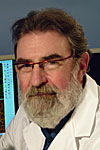Inflammation and oxidative stress in macular degeneration
Principal Investigator
Co-Principal Investigator
Project Goals
We will investigate the contribution of smoking to death of choriocapillaris (CC) and formation of choroidal neovascularization (CNV) in AMD. We will also evaluate the role of endogenous antioxidants in prevention of CC death and CNV in a clinically relevant animal model of AMD. Finally, using this model we will evaluate novel therapies to control the level of antioxidants (sulforaphane) and novel delivery systems for antioxidants and anti-angiogenic factors..
Project Summary
Age-related macular degeneration (AMD) is the leading cause of blindness in the elderly. The cause of AMD is not known but reactive oxygen species (ROS) or radicals have long been hypothesized to be causative in the disease. ROS are activated forms of oxygen that interact with and alter other molecules, so they are not functional. Smoking and aging are major sources of ROS and have been shown in every population study to be high risk factors for AMD. Anti-oxidants can inactivate ROS and a clinical trial of anti-oxidants showed a modest effect on progression of AMD.
We have recently developed a model for AMD in rats that mimics both dry AMD (photoreceptor and retinal pigment epithelium degeneration) and wet AMD (growth of choroidal neovascularization or CNV from the capillaries of choroid, the choriocapillaris). The model is created by injecting an oxidized lipid under the retina. This lipid was discovered in the Bruch's membrane of AMD subjects; Bruch's membrane separates retina and underlying choroid. In this proposal we will develop a similar model in mice so that we can take advantage of the powerful experimental resources available in mice.
Our study will determine the role of smoking and ROS in degeneration of the choriocapillaris, the small blood vessels in choroid. We will use an animal model of wet and dry AMD created by an oxidized lipid found in Bruch's membrane of AMD subjects. We will use this model to evaluate the effects of a powerful anti-oxidant (that scavenge ROS)/anti-angiogenic (that inhibit growth of new blood vessels) substances in liposomes or administer a substance that upregulates the cells own antioxidant production. These studies will help us better understand the cause of CC death in AMD and suggest therapies to avoid it.
The benefits of our studies to public health are an understanding of the effect of smoking on the blood supply (CC) for photoreceptors, the cells of vision in the retina. This is not known to date. It should produce new therapeutic entities that will control ROS from smoking and aging. It may also show the benefit of reducing ROS and increasing the antioxidants your own body makes in preventing AMD, by stimulating production of your own antioxidants with nutraceuticals like sulforaphane, which is found in many vegetables. The therapies that could result from our studies are far less invasive than monthly injections into the eye, which are now the standard of acre for wet AMD subjects.
Our proposal is unique because it involves a clinically relevant animal model of wet and dry AMD, since the lipid injected is in human AMD Bruch's membrane. The studies focus on the choroidal vasculature, the choriocapillaris, which we have recently demonstrated dies during wet and dry AMD. Our proposal is also unique because it proposes new ways of using antioxidants against ROS in smoking and AMD, and increases the cells own antioxidants defenses with a “nutraceutical” (sulforaphane). These antioxidants and anti-angiogenic molecules are delivered by a new method which supplies the molecules as lipid nanoparticles, or ”liposomes”.
Progress Updates
Age-related macular degeneration (AMD) is the leading cause of blindness in the elderly. The cause of AMD is not known but exposure to reactive oxygen species (ROS) or radicals have long been hypothesized to be associated with disease risk. ROS are activated forms of oxygen that interact with and alter other molecules, so they typically don’t have their own natural function. Smoking and aging are major sources of ROS and have been shown in every population study to be high risk factors for AMD.
Dr. Lutty and Bhutto’s team is now evaluating the choroid blood vessels of “smoking mice,” provided by another colleague at Johns Hopkins, Dr. James Handa. These mice lack a gene called Nrf2 in their endothelial cells (specialized cells that line blood vessels). Nrf2 normally initiates expression of endogenous antioxidants, so losing this gene puts the endothelial cells at risk for damage from ROS.
In addition, the team has recently developed a model for AMD in rat that mimics both dry AMD (photoreceptor and retinal pigment epithelium degeneration) and wet AMD (growth of CNV from the CC). The rat model is created by injecting under the retina an oxidized fat. Since the antioxidant Tocotrienol (DT-3, a derivative of vitamin E) inhibits endothelial cell growth, the team evaluated it topically (2X/day) using a number of delivery systems (three types of liposomes and one type of nanoemulsion). Unfortunately, DT-3 did not enter the eye in sufficient amounts to be useful therapeutically. The team is now evaluating a topical drug, called Unoprostone Isopropyl, from Sucampo. This drug penetrates the eye and has the potential of scavenging oxygen radicals as well as inhibiting angiogenesis (the abnormal growth of blood vessels). The therapies that could result from these studies are far less invasive than monthly injections into the eye, which are now the standard of care for wet AMD subjects.
First published on: April 01, 2010
Last modified on: November 22, 2024



